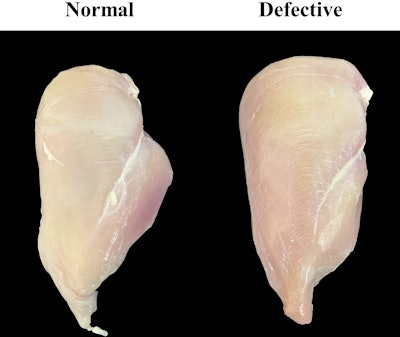
An optical imaging technology could potentially help poultry producers detect woody breast in processing plants.
The technology uses optical imaging and deep learning Artificial Intelligence (AI) systems to identify myopathies, such as woody breast, using cameras that look for meat defects.
The deep learning system works by taking historical knowledge and images entered by developers. This helps it learn to identify muscle myopathies. As the system is given more defects to detect, it will become quicker and more accurate in identification.
Yuzhen Lu, Ph.D., Michigan State University Biosystems and Agricultural Engineering Assistant Professor said the system can detect woody breast objectively, without affecting the product.
“AI models are data-hungry and computationally intensive.” stated Lu. “But with dedicated hardware and optimized model architectures, they can be readily used for online meat inspection at video frame rates.”
Identifying muscle myopathies such as woody breast is often done by poultry production employees on the processing line, which can be labor-intensive and inaccurate due to human error. The goal of the technology is to provide quick and accurate identification of the muscle myopathy, while providing cost savings to poultry processors, explained Lu.
“The poultry processing industry is operating on small margins,” said Lu. “This industry has a notoriously high labor turnover rate. Processors are under mounting pressure to reduce labor dependence and costs while delivering higher quality products, to remain competitive and profitable.”
After the initial laboratory research is completed, Lu said the technology will be tested in more practical applications. To further develop the technology, Lu is working on a light scattering imaging technique to be used for woody breast assessment.
Other woody breast detection technologies
Another system to detect woody breast, developed by U.S. Department of Agriculture (USDA) Research Electronics Engineer Dr. Seung-Chul Yoon, uses machine vision technology to measure the physical properties of poultry breast meat.
The technology uses a camera that takes up to 200 frames per second of breast meat fillets moving down the conveyer belt. The images are evaluated using an imaging processing technique to identify stiffness in the fillets, a sign of woody breast, when they are bent.


















